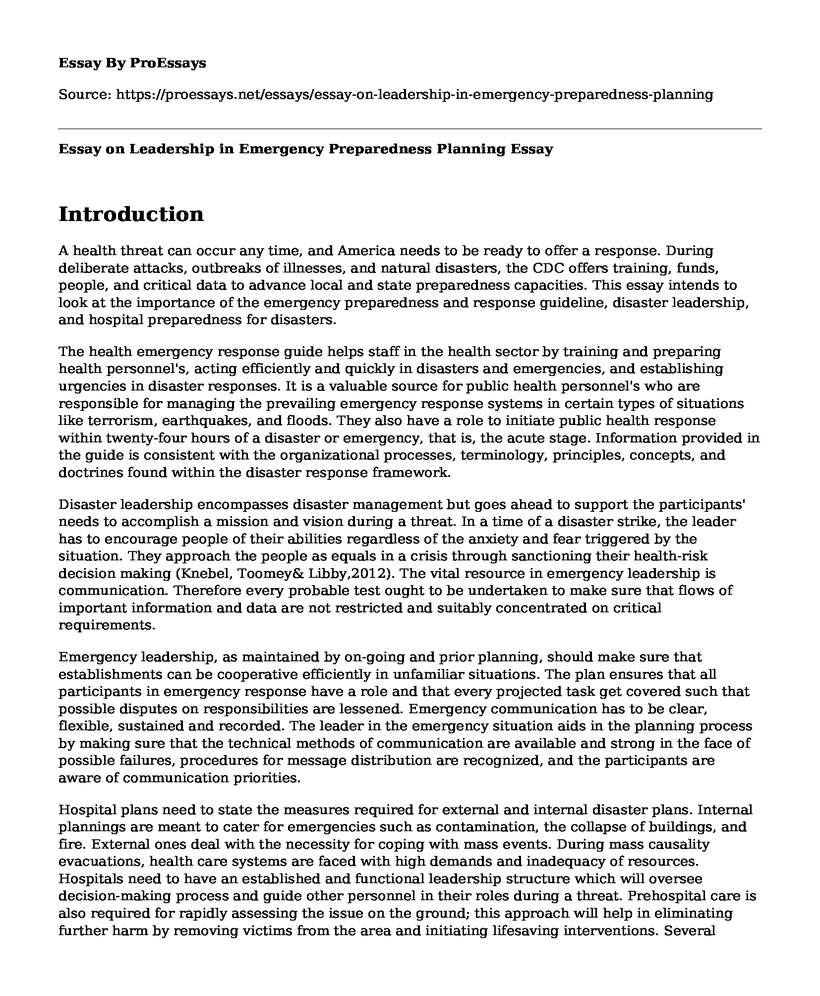Introduction
A health threat can occur any time, and America needs to be ready to offer a response. During deliberate attacks, outbreaks of illnesses, and natural disasters, the CDC offers training, funds, people, and critical data to advance local and state preparedness capacities. This essay intends to look at the importance of the emergency preparedness and response guideline, disaster leadership, and hospital preparedness for disasters.
The health emergency response guide helps staff in the health sector by training and preparing health personnel's, acting efficiently and quickly in disasters and emergencies, and establishing urgencies in disaster responses. It is a valuable source for public health personnel's who are responsible for managing the prevailing emergency response systems in certain types of situations like terrorism, earthquakes, and floods. They also have a role to initiate public health response within twenty-four hours of a disaster or emergency, that is, the acute stage. Information provided in the guide is consistent with the organizational processes, terminology, principles, concepts, and doctrines found within the disaster response framework.
Disaster leadership encompasses disaster management but goes ahead to support the participants' needs to accomplish a mission and vision during a threat. In a time of a disaster strike, the leader has to encourage people of their abilities regardless of the anxiety and fear triggered by the situation. They approach the people as equals in a crisis through sanctioning their health-risk decision making (Knebel, Toomey& Libby,2012). The vital resource in emergency leadership is communication. Therefore every probable test ought to be undertaken to make sure that flows of important information and data are not restricted and suitably concentrated on critical requirements.
Emergency leadership, as maintained by on-going and prior planning, should make sure that establishments can be cooperative efficiently in unfamiliar situations. The plan ensures that all participants in emergency response have a role and that every projected task get covered such that possible disputes on responsibilities are lessened. Emergency communication has to be clear, flexible, sustained and recorded. The leader in the emergency situation aids in the planning process by making sure that the technical methods of communication are available and strong in the face of possible failures, procedures for message distribution are recognized, and the participants are aware of communication priorities.
Hospital plans need to state the measures required for external and internal disaster plans. Internal plannings are meant to cater for emergencies such as contamination, the collapse of buildings, and fire. External ones deal with the necessity for coping with mass events. During mass causality evacuations, health care systems are faced with high demands and inadequacy of resources. Hospitals need to have an established and functional leadership structure which will oversee decision-making process and guide other personnel in their roles during a threat. Prehospital care is also required for rapidly assessing the issue on the ground; this approach will help in eliminating further harm by removing victims from the area and initiating lifesaving interventions. Several hospitals deal with the hospital and prehospital care, yet many of them do not consider the issues of victim transportation. Hospitals also need to equip themselves with enough inpatient structures - beds- and medical supplies in storage to be well prepared for any threat.
Conclusion
The planning guide also provides the society with tools, processes, and strategies for coordinated emergency management planning. Efficient response and preparedness require an operational leadership structure with clear responsibilities. Local hospitals are aware of their resources and needs and therefore ought to come up with certain medical services and possible plans for emergency preparedness and response. Confusions over responsibilities and roles can happen thus increasing the possibility of redundant gaps or efforts in response and decision-making.
Reference
Knebel, A. R., Toomey, L., & Libby, M. (2012). Nursing leadership in disaster preparedness and response. Annual review of nursing research, 30(1), 21-45.
Cite this page
Essay on Leadership in Emergency Preparedness Planning. (2022, Jun 02). Retrieved from https://proessays.net/essays/essay-on-leadership-in-emergency-preparedness-planning
If you are the original author of this essay and no longer wish to have it published on the ProEssays website, please click below to request its removal:
- Paper Example on Understanding Teamwork and Ideation Process
- Information Ethics and Information Security Essay
- Rational Decision-Making Model for Businesses Essay Example
- Technology Trends in Nursing and Healthcare Essay
- Exclusive Breastfeeding: AAP & ACOG Recommendations - Essay Sample
- Essay Example on Joint Commission: Improving Public Health for Over 70 Years
- Free Report Example on Men's Fertility & Fatherhood







